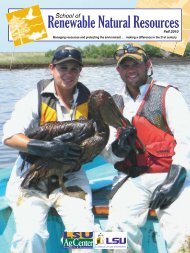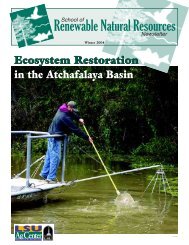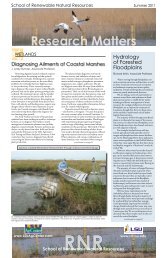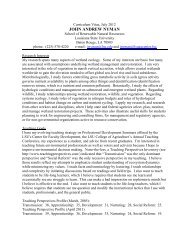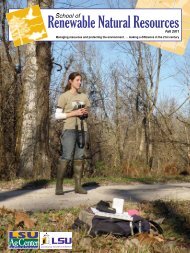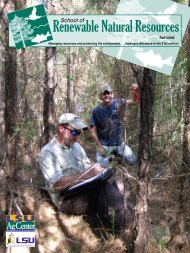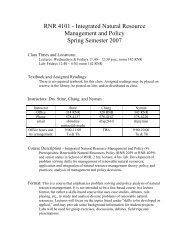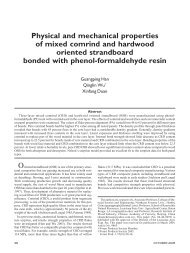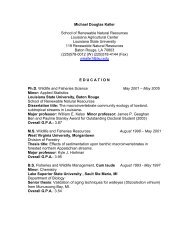Composite Materials Journal of Thermoplastic - LSU School of ...
Composite Materials Journal of Thermoplastic - LSU School of ...
Composite Materials Journal of Thermoplastic - LSU School of ...
You also want an ePaper? Increase the reach of your titles
YUMPU automatically turns print PDFs into web optimized ePapers that Google loves.
210 S.-Y. LEE ET AL.<br />
INTRODUCTION<br />
THE USE OF lignocellulosic materials and polymers from renewable<br />
resources has recently attracted increasing attention, predominantly due<br />
to environmental concerns and the depletion <strong>of</strong> petroleum resources [1–3].<br />
In general, polymers from renewable resources can be categorized into<br />
natural polymers such as starch [4–6], protein and cellulose [7–9], and<br />
synthetic polymers [10–12]. The development <strong>of</strong> synthetic polymers using<br />
monomers from natural resources provides a new direction for the<br />
development <strong>of</strong> biodegradable polymers.<br />
The most common biodegradable synthetic polymers are aliphatic<br />
polyesters such as polylactic acid (PLA), polyglycolic acids (PGA),<br />
polycaprolactone (PCL), and polyhydroxybutyrate (PHB). Among these<br />
biopolymers, PLA as biodegradable aliphatic polyester is <strong>of</strong> increasing<br />
commercial interest, because <strong>of</strong> its desired mechanical strength, thermal<br />
plasticity, and biocompatibility [13,14]. PLA has been used for many<br />
applications including grocery and composting bags, automobile panels,<br />
textiles, and bio-absorbable medical materials [15,16]. PLA is generally more<br />
expensive than many petroleum-derived commodity polyolefins such as<br />
polypropylene (PP) and polyethylene (PE). However, its price has been<br />
falling recently as more biopolymer production comes on-line [17].<br />
The compounding <strong>of</strong> fillers obtained from various sources into polymer<br />
matrices has been a well-accepted process to enhance mechanical and thermal<br />
properties <strong>of</strong> materials [1,2,18]. Wood flour (WF) and talc are two commonly<br />
used fillers for wood plastic composites (WPCs) [19,20]. The use <strong>of</strong> WF can<br />
reduce material costs and provide specific properties such as low density, high<br />
specific stiffness, and biodegradability [21–24]. In particular, WPCs with<br />
50 wt% or less plastic by weight, have been accepted by the construction<br />
industry and homeowners, largely for decking, fencing, ro<strong>of</strong>ing, window<br />
pr<strong>of</strong>ile, and automotives [21]. Talc (up to 30% by weight) can have a positive<br />
influence on modulus, strength, processing efficiency, creep and elastic recovery<br />
performance <strong>of</strong> WPCs [25]. A combination <strong>of</strong> organic (e.g., wood) and<br />
inorganic (e.g., talc) fillers in PLA may lead to interesting composite properties.<br />
In the intricate structure and morphology <strong>of</strong> polymer reinforced by<br />
organic and/or inorganic fillers, there is a problem related to the character<br />
and extent <strong>of</strong> interaction at the polymer-filler interfaces [21]. The established<br />
procedure for improving the interfacial adhesion <strong>of</strong> polymer and wood fiber<br />
is the use <strong>of</strong> coupling agent, resulting in a good chemical and/or physical<br />
bonding between polymer matrix and particle surfaces [26]. For example,<br />
various types <strong>of</strong> silanes have been developed to promote the interfacial<br />
adhesion. Organo-functional silanes are used to couple organic polymers<br />
with inorganic materials such as talc, silica, and mica [27].<br />
Downloaded from http://jtc.sagepub.com at KAIST GRADUATE SCHOOL OF MGMT on April 27, 2008<br />
© 2008 SAGE Publications. All rights reserved. Not for commercial use or unauthorized distribution.



